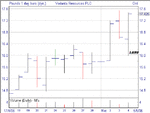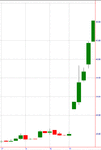First let me repeat some extracts from frugi’s excellent and perceptive posts as they are well worth reading again. They express my views extremely well.
QUOTE
But assuming one can position safely in XYZ, whether it be 100 or 1000 shares (this obviously depends on capital, stop loss & potential "disaster scenario") with a view to capturing a 20c move, but at 20c to the good the instrument looks like giving more than this, then why cut all your profit there? After all you do not risk more than your original stop loss in doing this. I believe this was all Richard meant - why always insist on a scalp when some scalps may turn into runs?
This is not in my view the sign of a bad trader, quite the opposite. It is one who always cuts losses and runs profits where appropriate.
Also, though I may have misunderstood you, a trader's edge does not have to be as mathematically pure as you claim. Your approach seems generally to be based on repetitive statistical patterns (although I think with a momentum-based exit in some cases?) and it works well for you. That is excellent and I respectfully commend the research and discipline that has led to this happy, consistent result.
But please do not assume that everyone must trade in exactly the same way to be profitable. For instance I disagree that one must take the volatility of the instrument into account when calculating pos size and stop loss. There is more than one way to skin this market cat.
A stock can trade in a quiet range for x time, resulting in low historical volatility, but then suddenly explode as a result of a new supply / demand imbalance. At this point, the stop loss that was suitable by your criteria for the range will then be unsuitable for the new market condition, surely? It is only after this has occured that the historical volatility will increase, which is too late to adjust your stop.
And then, just when you've widened your stop to take account of this the volatility contracts again and you may take a larger loss than is appropriate given the current price action. All I am saying is that since expansion / contraction cycles are not accurately predictable then taking their past behaviour in this regard into account seems imho somewhat unecessary and certainly not essential. However as I said this mathematical approach really isn't my style and I apologise if I have misread or oversimplified your methodology. Also it clearly works well for you, so I am not for as moment saying you are wrong, just that it is not essential for everyone to follow the same approach.
But given two stocks of equal size with the same stop loss and capital at risk I would still prefer the "hot" one that was more likely to run further, probably due to news/earnings, than the dull one that no pro has bothered to trade since last November
END QUOTE
I’d also like to quote some perceptive words from The Bramble which are also absolutely spot on:
QUOTE
The only proviso I'd make is that with the smaller absolute moves, the trading costs become more of an an issue and your performance less effective. Your risk:reward also skews against you.
Having said that though, and as Richard says, take what's on offer!
END QUOTE
When I coach people I do NOT tell them to leap into the market and immediately trade dangerous stocks, just the opposite.
Obviously the wider the intra-candle range the more dangerous and beginners must shun such stocks. However, IF the behaviour of the stock is clean and readable then there is potential there to trade, albeit on SMALLER position size.
I do not coach people to leap in trading 1000 shares of anything, even MSFT.
I give everyone an individual trading plan which involves initially paper trading. If they reach certain set targets, which include win/loss ratio, ave win size to ave loss size over a sufficiently long period of time to be statistically significant, then I suggest they start real trading 100 shares only and have to achieve the same targets before progressing slowly and gradually up to larger size. This helps build confidence and experience.
Slowlee slowlee, catchee monkey.........
For example, in post 129, I said,
“My stop was a failure of momentum so had it gone pear shaped, (rather unlikely), I would have lost a maximum of 2c as there was loads of stock to buy.
The price fell immediately as expected and I simply watched it fall seeing that the noise was never more than a 2c rise; this told me that as soon as the price rose 3c - at the very latest - I should cover. In other words my initial stop was on a failure of momentum and my trailing stop was on a change in behaviour on micro-analysis.
When the ask started rising I covered and grabbed 20c profit in two minutes off a no brainer with tiny risk.
All the time I was in total control, knowing exactly what I would do under any circumstances.”
If read carefully, in fact look at the whole post and the image for context, that gives an idea of the way I do things.
In another post I said,
“If I can't find something that is moving into one of my set ups to maximise profit potential, I do look at minor moves of various types in slower stocks like SYMC, JNPR, DELL etc and then take 3000 shares to make it worthwhile.”
So yes, I take small profits if that is all there is to take !
But, yes, I stand by my comment that you should go where the bigger profit potential is. It is axiomatic that all positions are taken with tight risk control.
Again,
“I see things differently. Volatility = opportunity, BUT ONLY IF IT'S READABLE. If price is simply all over the place and I can't read the movement, i.e. the "noise" is too great, then that sort of volatility I walk away from.
In other words my view of volatility is controlled by whether it is readable or not and also whether there is plenty of depth and liquidity for me to exit with zero or tiny loss if the trade doesn't pan out. I abhor unnecessary risk taking.
These comments on volatility are merely the tip of the iceberg and will doubtless be misunderstood by some.”
Everyone to their own style; there is nothing wrong with anything that works consistently and profitably.”
Look at the penultimate sentence................
So, let me repeat, I go to the hot stocks first. May I define hot?
Hot = greatest likelihood of big moves for big profit.
If there are no such possibilities I go for my core trading stocks and take smaller cent moves.
When I enter a trade I do NOT know where it might go. No-one does. I will only consider entering any trade if it sets up in one of my patterns AND then triggers according to my criteria.
The advantage of hot stocks is that they can move much further thus generating more profits. Sometimes they shift a dollar or two, sometimes just 10 or 20 cents and everything in between.
I take what the market gives me and rarely exit a trade if it is still running UNLESS the chart or level2 gives me a clue that the move might end.
I believe in letting profits run – you simply do not know when a run might end so why take an arbitrary profit unless the market is very thin and choppy.
That question is also rhetorical, as is the comment about “Why mess around taking a few cents here and a few cents there when there are almost always hot stocks around you can get a $ run from???”
That was NOT meant to be offensive to anyone !
It meant go with the flow, don’t exit just for a few cents if it is still running. That’s it !
My risk remains the same because I am position sized appropriately and choose my stocks extremely carefully.
Now, Iraj and I both have tight risk control in different ways.
As far as I can see, he is a highly technical and mathematical trader and that is one excellent way of trading. His measure of volatility seems historically based.
I’m different, I look at a chart and see the way the stock is behaving today. I look at level 2 and see the way it is behaving today. As frugi pointed out, such behaviour today can be and often is quite different to historical behaviour.
The word volatile suggests unreadable, dangerous to almost everyone.
I don’t think the same way.
Volatile to me means large move. However there are two sub divisions.
The first is an unreadable ERRATIC move. That is dangerous and I have zero interest in that type of situation.
The second is a bit more subtle. A stock might appear to travel over a huge range over say three five minute candles. Looking at it over one minute candles there are often tradable moves within that time frame. Looking at level 2 in conjunction with that, you can sometimes see clear and clean direction and pressure (momentum) on a more micro –level.
Therein lie the opportunities for large profitable moves with minimum risk.
I also trade on longer time frames, mainly five minute candles, but often will enter and exit because of micro triggers.
I have spent a long time on this post with my slow two finger typing because I really feel that if people can step out of their own self imposed terms of reference and open themselves up to understanding something different, they will see things they previously haven’t.
I have a great interest in the way others trade, whether I agree or not, whether it is simply not my thing or whatever.
That, to me is what these boards are about.
Richard




